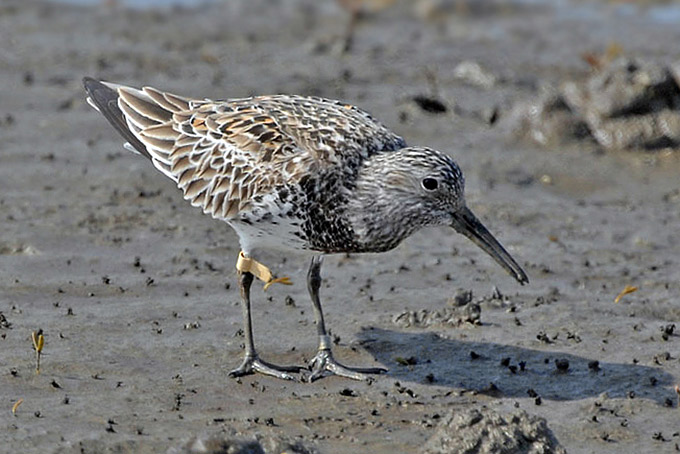Homepage article May 2008
Great Knot Calidris tenuirostris

Great Knot Calidris tenuirostris, April 2008, Photo © Shim Kyu-Sik
The Great Knot
Calidris tenuirostris is a bivalve-specialist confined to Asia (where it breeds in the Far North-East) and Australia (where the vast majority spend the boreal winter), with a global population estimated at 385,000 (Wetlands International, 2006). Undertaking massive migrations, most of the world’s Great Knot stage in the Yellow Sea on both northward and southward migration, with some in March and April apparently migrating direct to Korea from Australia, and others, based on leg-flag observations, first staging on the Chinese coast. In total, South Korean tidal-flats are believed to support 150,000 Great Knot on northward and 160,000 on southward migration respectively (Moores, 2006), with huge, dense flocks concentrated on extensive shellfish-rich tidal-flats in two main areas: Saemangeum and the Geum Estuary in the west, and Gyeonggi Bay in the northwest. Until seawall closure in 2006, the Saemangeum area held the world’s largest concentration of the species (with for example a single count there of 123,745: in Moores et al., 2006), while further sites such as Asan Bay and Namyang Bay have also been extremely important for the species (e.g. 18,000 and 12,500 were counted at the two sites on May 8th and 9th, 1998: Moores, 1999). Now, reclamation of Saemangeum, of Namyang Bay (with the seawall also closed there in 2006), and of most of the tidal-flats of Asan Bay (still ongoing) apparently threatens the long-term health of the global population of this species. The ongoing Birds Korea-Australasian Wader Studies Group Saemangeum Shorebird Monitoring Program (April-May, 2006-2008), and the National Shorebird Survey (conducted along the west and south coasts of South Korea between May 3rd and 15th, 2008) both aim to gather scientifically rigorous data on the numbers of Great Knot and other shorebird species remaining in Korea - helping to assess the impacts of tidal-flat reclamation, and supporting domestic and international calls for the conservation of shorebirds and their highly threatened tidal-flat habitat.
References
- Moores, N. 1999. A survey of the distribution and abundance of shorebirds in South Korea during 1998-1999. Stilt 34: 18-29.
- Moores, N. 2006. South Korea’s Shorebirds: a review of abundance, distribution, threats and conservation status. Stilt (50) 2006: 62-72. Published by the Australasian Wader Studies Group.
(Available at: http://www.birdskorea.org/Birds/PDFs/Downloads/NialMoores-SK-shorebirds-2006.pdf).
- Moores, N., Battley, P., Rogers, D., Park M-N, Sung H-C, van de Kam, J., & K. Gosbell, 2006. Birds Korea-AWSG Saemangeum Shorebird Monitoring Program Report, 2006. Birds Korea publication, Busan.
(Available at: http://www.birdskorea.org/Habitats/Wetlands/Saemangeum/Downloads/Birds-Korea-SSMP-Report-2006.pdf).
- Wetlands International. 2006. Waterbird Population Estimates - Fourth Edition. Wetlands International, Wangeningen, The Netherlands

Great Knot Calidris tenuirostris, September 2006, Photo © Shim Kyu-Sik





